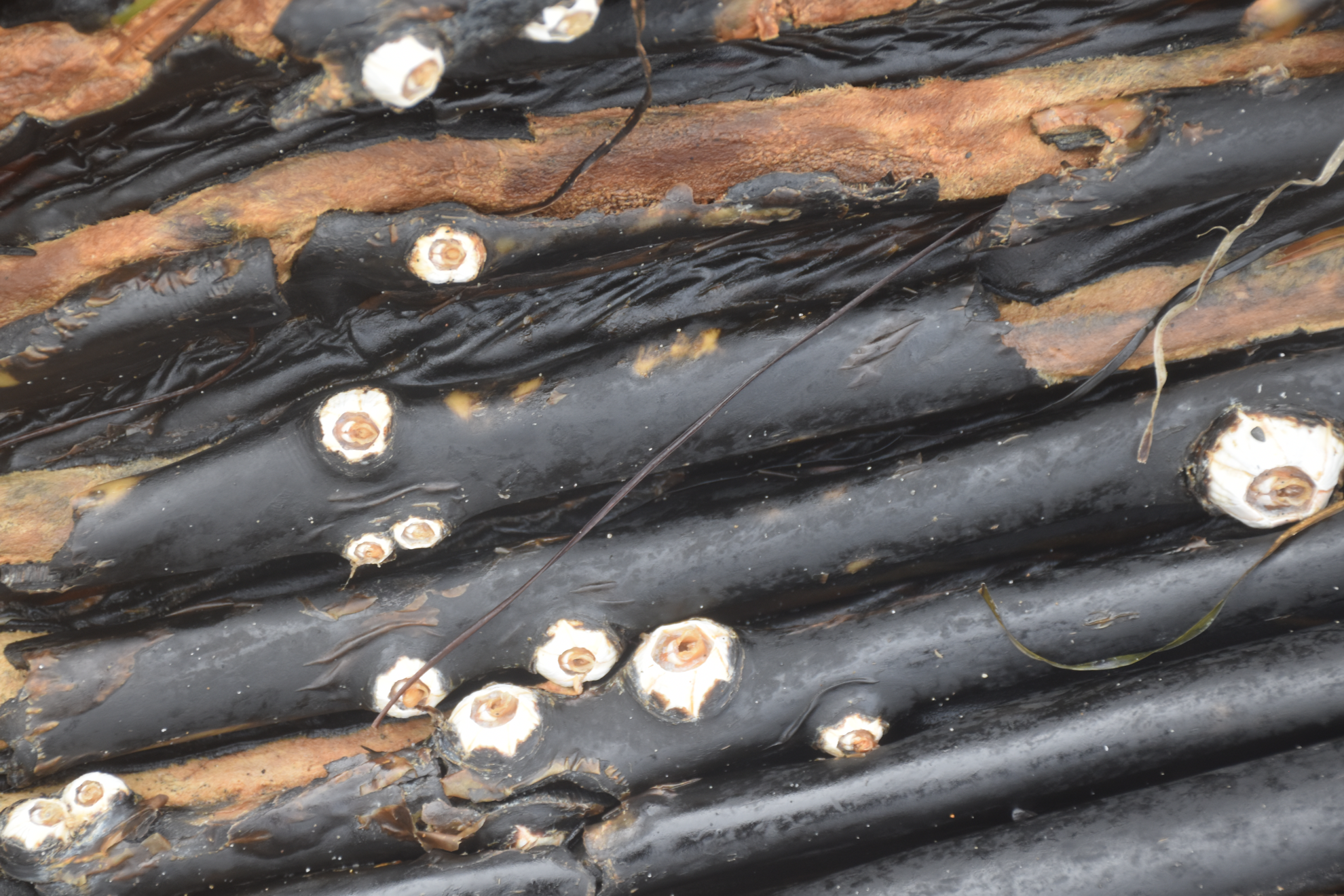Coronula diadema Linnaeus, 1767Common name(s): Whale barnacle |
|
| Synonyms: |  |
|
Phylum Arthropoda
Subphylum Crustacea
Class Maxillopoda
Order Sessilia
Superfamily
Coronuloidea
Family Coronulidae
Subfamily
Coronulinae
|
|
| Coronula diadema on the lower side of the throat of a humpback whale on a Washington coast beach. Both the whale and the barnacle are thoroughly dead. The barnacle's rostrum and the front of the whale are to the left. The diameter of this barnacle is about 3 to 3.5 cm. | |
| (Photo by: Dave Cowles, July 2021) | |
Description:Coronula diadema is one of only six living species of barnacles that have been found on whales. This species is distinct from other whale barnacles because it stands tall and upright on the whale skin without being deeply embedded, but does not grow a fleshy stalk. It has six fixed plates which stand largely upright and have strong vertical ridges and which also have horizontal undulations near their basal ends. This plate configuration gives it the diadema (crown) designation and is sometimes referred to as "barrel-shaped" in the literature. Its movable plates (terga and scuta) are not as well developed as they are in barnacles from Family Balanidae but they do have an opercular membrane which is yellowish and contains one pair of valves which can close the opening (see photo above). The barnacle can grow to 30-59 mm tall, projecting from the whale's skin, and to 8.5 cm diameter.
How to Distinguish from Similar Species:Coronula reginae, the most similar species, also is common on humpback whales. It also has six plates but does embed somewhat in the skin. It only grows to about 13-19 mm tall and in larger individuals the wall plates become flattened rather than standing tall as they do in C. diadema.
Geographical Range: Worldwide, northern and southern hemisphere
Depth Range: Epipelagic (on whales)
Habitat: Mainly on humpback whales, especially around the head, fins, and throat. Occasionally on other whale species such as blue, right, fin, sei, and sperm whales.
Biology/Natural
History: The rostrum
of this species faces the anterior end of the whale, so that the cirri
(feet), when extended, face the oncoming current as the whale swims.
The
cirri
do not project far out of the aperture, however, probably due to the
high
current speeds the barnacle would encounter due to the whale's swimming
speed. The species is thought to be a commensal symbiont, living on the
whale while doing it no harm or benefit. Some humpback whales may use
rough
parts of their skin, covered with barnacles, to fend off orca whales
however,
in which case the barnacles would be mutualist symbionts. Another
barnacle,
the smaller stalked Conchoderma
auritum and less often Conchoderma
virgatum, often attach to the downstream fixed plates (carina)
of this species. C.
diadema
is thought to have a lifespan of one year or less. Observers have
reported
that the species has mostly small individuals in early summer, with
larger
individuals in late summer and in winter, but these may disappear in
late
winter, replaced by settling larvae. The larvae hatch as nauplii
then transition to a nonfeeding cypris
larva which settle when exposed to a piece of the whale's skin.
| Return to: | |||
| Main Page | Alphabetic Index | Systematic Index | Glossary |
References:
Dichotomous Keys:Kozloff, 1987, 1996 (mentioned but not keyed)
General References:
Morris
et al., 1980
Scientific Articles:
Cornwall, I.E., 1924. Notes on West American whale barnacles. Proceedings of the California Academy of Sciences Series 4, 13 (26): pp. 421-431
Cornwall, I. E., 1927. Some North Pacific whale barnacles. Contributions to Canadian Biology and Fisheries 3: pp. 503-517
Crisp, D.J., and H. G. Stubbings, 1957. The orientation of barnacles to water currents. Journal of Animal Ecology 26: pp. 179-196
Darwin, Charles, 1854. A monograph on the sub-class Cirripedia, vol. 2. Royal Society of London. 684 pp., 30 plates
Newman, W.A., and A. Ross, 1976. Revision of the balanomorph barnacles; including a catalog of the species. San Diego Natural History Museum Memoir 9: pp. 1-108
Nogata, Yasuyuki and Klyotaka Matsumura, 2005. Larval development and settlement of a whale barnacle. Biological Letters 2: pp. 92-93. https://doi.org/10.1098/rsbl.2005.0409
Scarff, James E., 1982. Occurrence of the barnacles Coronula diadema, C. reginae and Cetopirus complanatus (Cirripedia) on Right Whales. Scientific Report Whales Research Institute No. 37 pp. 129-153
Web sites:
General Notes and Observations: Locations, abundances, unusual behaviors:
More Coronula diadema barnacles on
the same whale. Notice how
a slight flap of skin covers the very base of the barnacles but they
are
not sunken into the skin.
The whole barnacleed whale, lying belly-up (supine) on
the beach. This
individual appears to be a juvenile. 
Authors and Editors
of Page:
Dave Cowles (2021): Created original page
CSS coding for page developed by Jonathan Cowles
Salish Sea Invertebrates web site provided courtesy of Walla
Walla University